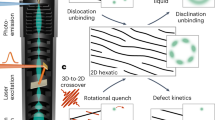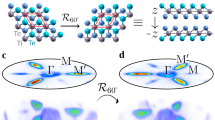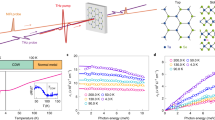Abstract
Low-dimensional electron systems, as realized in layered materials, often tend to spontaneously break the symmetry of the underlying nuclear lattice by forming so-called density waves1; a state of matter that at present attracts enormous attention2,3,4,5,6. Here we reveal a remarkable and surprising feature of charge density waves, namely their intimate relation to orbital order. For the prototypical material 1T-TaS2 we not only show that the charge density wave within the two-dimensional TaS2 layers involves previously unidentified orbital textures of great complexity. We also demonstrate that two metastable stackings of the orbitally ordered layers allow manipulation of salient features of the electronic structure. Indeed, these orbital effects provide a route to switch 1T-TaS2 nanostructures from metallic to semiconducting with technologically pertinent gaps of the order of 200 meV. This new type of orbitronics is especially relevant for the ongoing development of novel, miniaturized and ultrafast devices based on layered transition metal dichalcogenides7,8.
This is a preview of subscription content, access via your institution
Access options
Subscribe to this journal
Receive 12 print issues and online access
$259.00 per year
only $21.58 per issue
Buy this article
- Purchase on SpringerLink
- Instant access to full article PDF
Prices may be subject to local taxes which are calculated during checkout
 supercell structure of 1T-TaS2.
supercell structure of 1T-TaS2.



Similar content being viewed by others
References
Grüner, G. Density Waves in Solids Vol. 89 (Addison-Wesley, 1994).
Chang, J. et al. Direct observation of competition between superconductivity and charge density wave order in Y Ba2Cu3O6.67 . Nature Phys. 8, 871–876 (2012).
Ghiringhelli, G. et al. Long-range incommensurate charge fluctuations in (Y, Nd)Ba2Cu3O6+x . Science 337, 821–825 (2012).
Da Silva Neto, E. H. et al. Ubiquitous interplay between charge ordering and high-temperature superconductivity in cuprates. Science 343, 393–396 (2014).
De la Cruz, C. et al. Magnetic order close to superconductivity in the iron-based layered LaO1−xFxFeAs systems. Nature 453, 899–902 (2008).
Mühlbauer, S. et al. Skyrmion lattice in a chiral magnet. Science 323, 915–919 (2009).
Wang, Q. H., Kalantar-Zadeh, K., Kis, A., Coleman, J. N. & Strano, M. S. Electronics and optoelectronics of two-dimensional transition metal dichalcogenides. Nature Nanotech. 7, 699–712 (2012).
Chhowalla, M. et al. The chemistry of two-dimensional layered transition metal dichalcogenide nanosheets. Nature Chem. 5, 263–275 (2013).
Sipos, B. et al. From Mott state to superconductivity in 1T-TaS2 . Nature Mater. 7, 960–965 (2008).
Fazekas, P. & Tosatti, E. Electrical, structural and magnetic properties of pure and doped 1T-TaS2 . Phil. Mag. B 39, 229–244 (1979).
Hellmann, S. et al. Ultrafast melting of a charge-density wave in the Mott insulator 1T-TaS2 . Phys. Rev. Lett. 105, 187401 (2010).
Petersen, J. C. et al. Clocking the melting transition of charge and lattice order in 1T-TaS2 with ultrafast extreme-ultraviolet angle-resolved photoemission spectroscopy. Phys. Rev. Lett. 107, 177402 (2011).
Perfetti, L. et al. Time evolution of the electronic structure of 1T-TaS2 through the insulator–metal transition. Phys. Rev. Lett. 97, 067402 (2006).
Wu, X. L. & Lieber, C. M. Hexagonal domain-like charge density wave phase of 1T-TaS2 determined by scanning tunneling microscopy. Science 243, 1703–1705 (1989).
Spijkerman, A., de Boer, J. L., Meetsma, A., Wiegers, G. A. & van Smaalen, S. X-ray crystal-structure refinement of the nearly commensurate phase of 1T-TaS2 in (3 + 2)-dimensional superspace. Phys. Rev. B 56, 13757–13767 (1997).
Ang, R. et al. Real-space coexistence of the melted Mott state and superconductivity in Fe-substituted 1T-TaS2 . Phys. Rev. Lett. 109, 176403 (2012).
Tanda, S., Sambongi, T., Tani, T. & Tanaka, S. X-ray study of charge density wave structure in 1T-TaS2 . J. Phys. Soc. Jpn 53, 476–479 (1984).
Nakanishi, K. & Shiba, H. Theory of three-dimensional orderings of charge-density waves in 1T-TaX2 (X: S, Se). J. Phys. Soc. Jpn 53, 1103–1113 (1984).
Bovet, M. et al. Interplane coupling in the quasi-two-dimensional 1T-TaS2 . Phys. Rev. B 67, 125105 (2003).
Darancet, P., Millis, A. J. & Marianetti, C. A. Three-dimensional metallic and two-dimensional insulating behavior in octahedral tantalum dichalcogenides. Phys. Rev. B 90, 045134 (2014).
Damascelli, A., Hussain, Z. & Shen, Z-X. Angle-resolved photoemission studies of the cuprate superconductors. Rev. Mod. Phys. 75, 473–541 (2003).
Ku, W., Berlijn, T. & Lee, C-C. Unfolding first-principles band structures. Phys. Rev. Lett. 104, 216401 (2010).
Rossnagel, K. On the origin of charge-density waves in select layered transition-metal dichalcogenides. J. Phys. Condens. Matter 23, 213001 (2011).
Pillo, T. et al. Remnant Fermi surface in the presence of an underlying instability in layered 1T-TaS2 . Phys. Rev. Lett. 83, 3494–3497 (1999).
Stojchevska, L. et al. Ultrafast switching to a stable hidden quantum state in an electronic crystal. Science 344, 177–180 (2014).
Koepernik, K. & Eschrig, H. Full-potential nonorthogonal local-orbital minimum-basis band-structure scheme. Phys. Rev. B 59, 1743–1757 (1999).
Brouwer, R. Incommensurability in Crystal Structures PhD thesis, Rijksuniversiteit Groningen (1978)
Rossnagel, K., Rotenberg, E., Koh, H., Smith, N. V. & Kipp, L. Continuous tuning of electronic correlations by alkali adsorption on layered 1T-TaS2 . Phys. Rev. Lett. 95, 126403 (2005).
Acknowledgements
This work was financially supported by the German Research Foundation under grant DFG-GRK1621. J.T. and J.G. gratefully acknowledge financial support by the German Research Foundation through the Emmy Noether program (grant GE 1647/2-1). Y.I.J. and P.A. were supported by US Department of Energy grant DE-FG02-06ER46285. We thank K. Rossnagel for fruitful discussions.
Author information
Authors and Affiliations
Contributions
J.G. and P.A. conceived the research project on 1T-TaS2. T.R., J.T., Y.I.J., M.v.Z. and J.G. conducted the synchrotron experiments. H.B. grew the single crystals. T.R., J.T. and K.K. performed the DFT calculations. T.R., J.T. and J.G. analysed the results and developed the concept of orbitronics. T.R., J.T., K.K., M.v.Z., P.A., B.B. and J.G. prepared the manuscript.
Corresponding authors
Ethics declarations
Competing interests
The authors declare no competing financial interests.
Rights and permissions
About this article
Cite this article
Ritschel, T., Trinckauf, J., Koepernik, K. et al. Orbital textures and charge density waves in transition metal dichalcogenides. Nature Phys 11, 328–331 (2015). https://doi.org/10.1038/nphys3267
Received:
Accepted:
Published:
Issue date:
DOI: https://doi.org/10.1038/nphys3267
This article is cited by
-
Dualistic insulator states in 1T-TaS2 crystals
Nature Communications (2024)
-
Endotaxial stabilization of 2D charge density waves with long-range order
Nature Communications (2024)
-
Non-equilibrium quantum domain reconfiguration dynamics in a two-dimensional electronic crystal and a quantum annealer
Nature Communications (2024)
-
Orbital-selective charge-density wave in TaTe4
npj Quantum Materials (2023)
-
Order-disorder phase transition driven by interlayer sliding in lead iodides
Nature Communications (2023)



